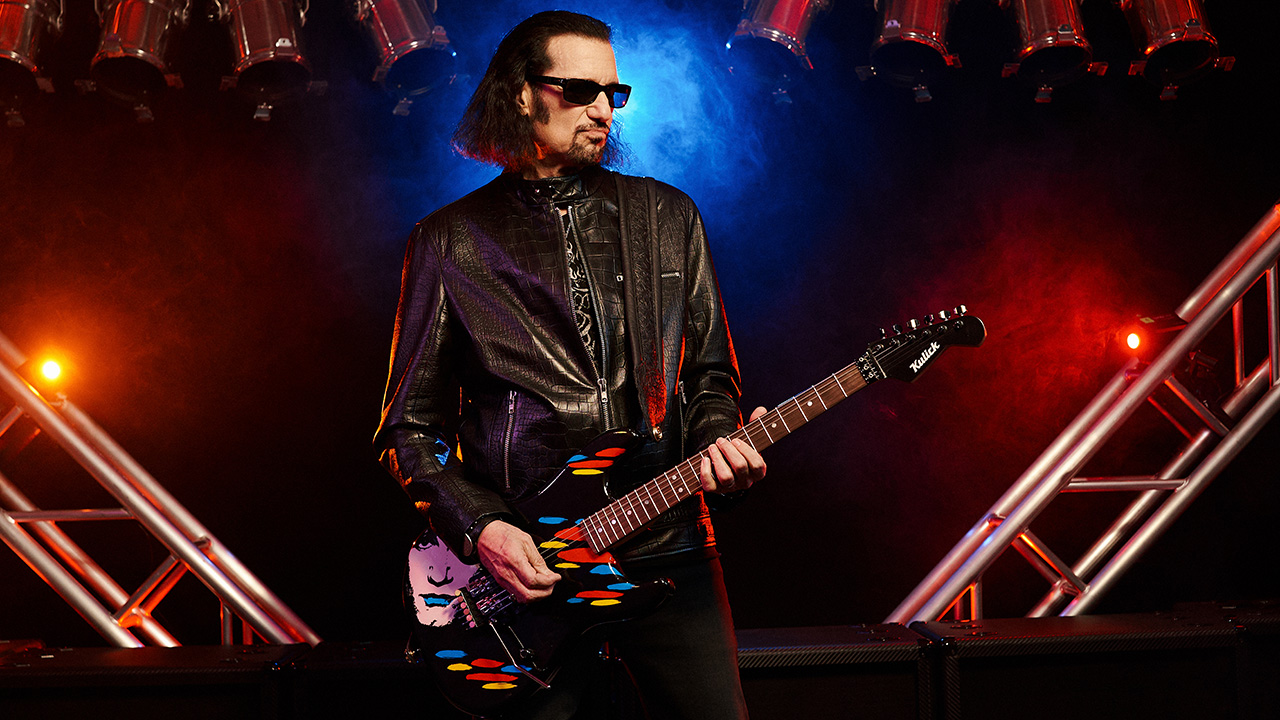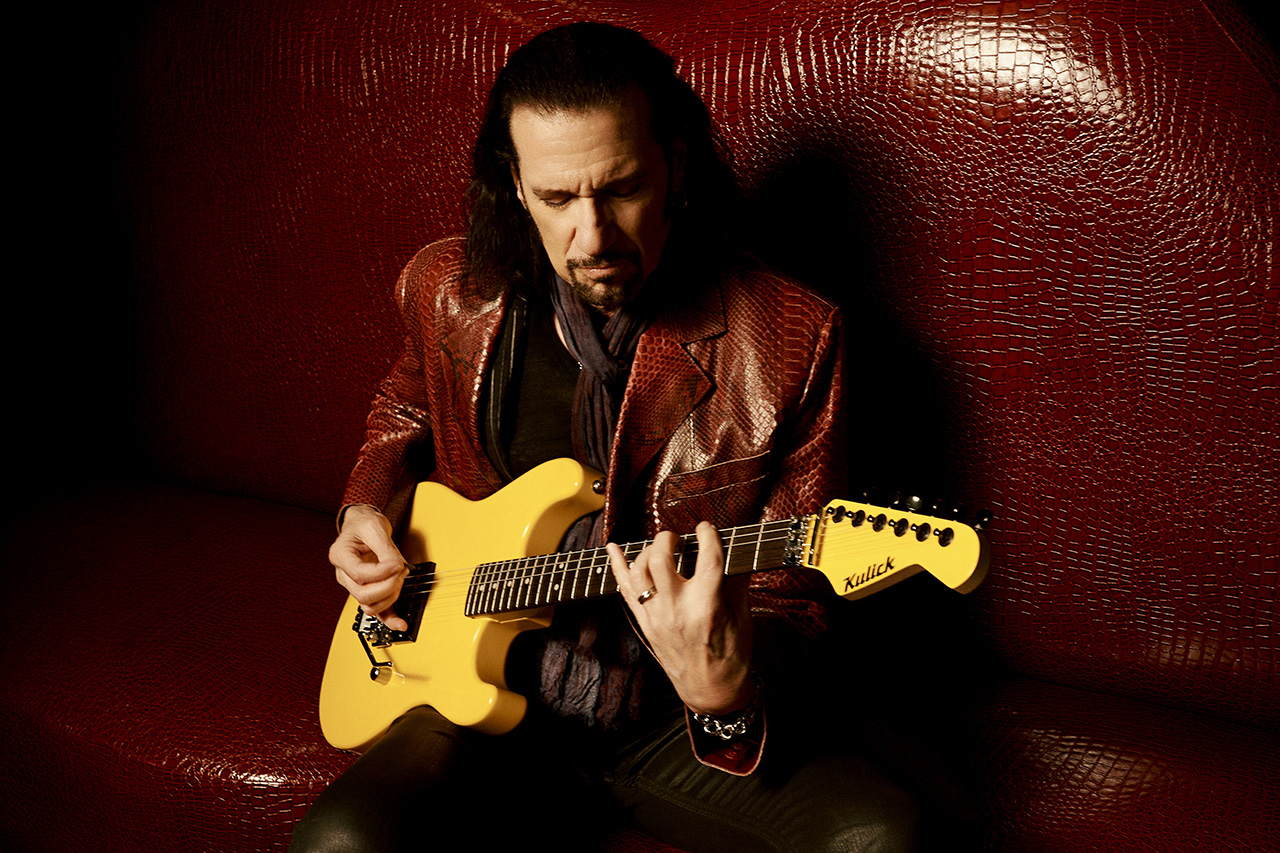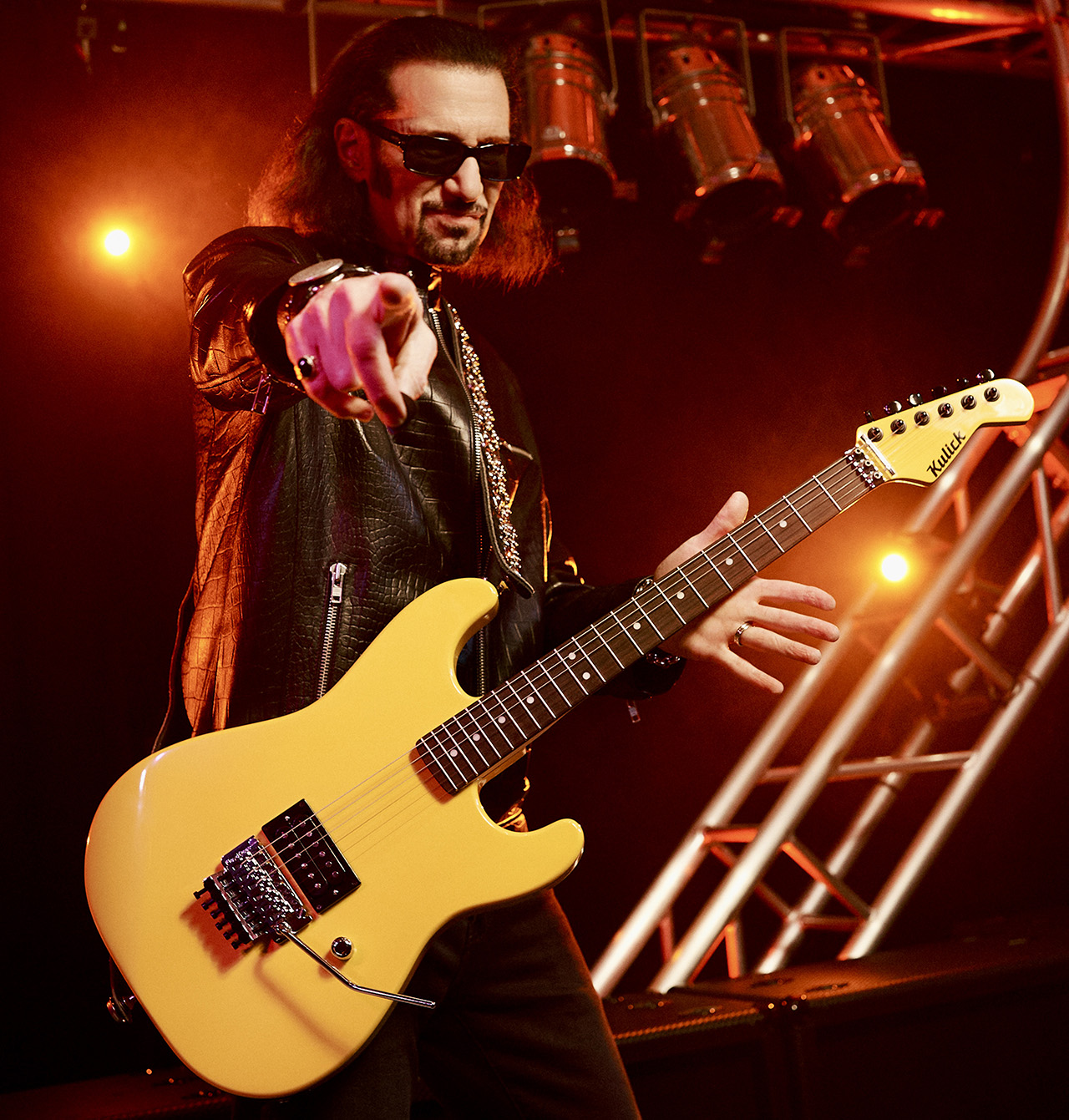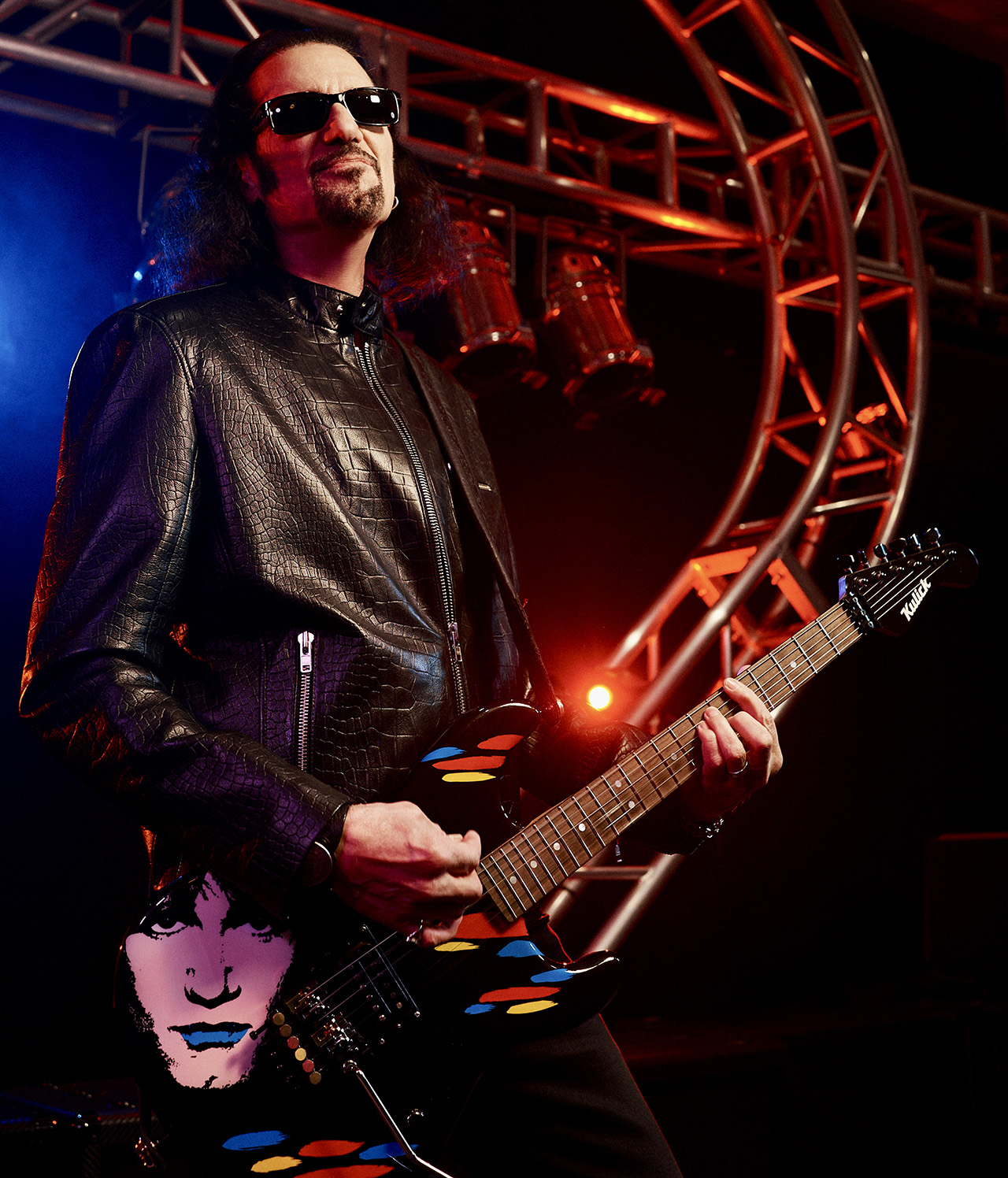
Bruce Kulick was a low-key Superstrat shredder with Kiss in the ’80s, but during his time with Grand Funk Railroad he kept things more traditional. But after leaving that band last year, he tells Guitar World, he wanted to return to “powerful instruments with the Floyd Rose – the opposite to what was appropriate for Grand Funk.”
He explains: “I jumped in the rabbit hole of discovery. I’m learning every step of the way. I want to know what made my Kiss guitars so great.”
Kulick found help from Johnny DiFatta, a California-based guitar maker whose AXN Guitars is based on small-batch quality. “I manufacture a few guitars a year,” DiFatta says. “AXN will continue to be concerned more about uniqueness and individuality instead of quantity and high production.”
That commitment, along with DiFatta’s childhood fascination with Kiss, make a perfect match with Kulick. “Who better to influence my brand? Once Bruce and I became friends, many details I learned from him were incorporated into AXN.”
To date, he’s helped craft reproductions of Kulick’s well-loved banana ESP M-1, and an M-1–style guitar featuring the player’s likeness from the cover of 1985 Kiss album Asylum. The instruments feature Kulick’s name on the headstock.
“My guitars are an evolution,” DiFatta asserts. “AXN is the culmination of all the best things that have come from the history of handmade guitars. That’s why I call my them ‘luthier-grade’ guitars.”
Kulick hopes to develop a line of boutique instruments. “These guitars should be played, not just hung on a wall,” he says. “I’d like to offer some of the paint designs I created during my Kiss years. It will be an evolving endeavor that I’m compelled to explore.”
How did your relationship with Johnny DiFatta begin?
“It began with us sharing our passion for the guitars from the ‘80s. Johnny’s knowledge of these instruments is tremendous, and matches my experience as a guitar slinger of the time, inspiring many spirited conversations.
“My early Kiss Superstrats were Charvels with the gold decal and angle headstock, loaded to EMGs. But, after [1985’s] Animalize I was introduced to ESP. The early M-1 models had necks that were better in my hand.

“In January 2020, I received a beautiful Superstrat from AXN. Its finish was based on my Asylum-era flip-flop blue. When Johnny showed me his ability, asking me to explore period-correct guitars with him, I was excited to oblige.”
You’ve dipped your toe into the boutique guitar world before.
They should feel good in my hand, and no matter where you bend a string, the guitar needs to sing… my goal is to keep them as close to eight pounds as possible
“My heavily relic’d Bruce Kulick Les Paul Jr. model was special for the fans that purchased it. Rock N Relics did a great job making an instrument that’s a real challenge – recreating a beat-up guitar from 1957 is not easy! I learned from that.”
What makes AXN a good partner?
“Our goal was to make a guitar that says, ‘Look at me!’ I rebranded myself with a new logo font for my name, which I was very proud of. I wanted to create boutique-quality guitars with my name on them, and Johnny could provide high-quality bodies and necks.
“The Asylum guitar got exactly the reaction I wanted when people saw it. Soon after the flip flop blue got a standard AXN neck on it, Kulick was on the headstock as well.”

“Then it was time to get an unfinished neck and body from Johnny, and make a banana guitar locally in Las Vegas. A Las Vegas-based luthier named Gil Rosado helped with the build. Seymour Duncan's MJ made me a pickup I love, and the guitar is a great tribute. It’s not an exact replica – this new one has a matching headstock, one volume knob, and it screams rock ’n’ roll!”
What are the challenges in recreating legacy instruments?
“It’s simple to have a vision, but having it actually become real is the challenge. I’ve been learning all the time; my last few years have been very insightful, discovering all the intricacies of these guitars. And don’t get me started about how complex the tremolo systems are – Floyd Rose installations and setups can be very personal to each player.”
What are your must-have specs?
“They should feel good in my hand, and no matter where you bend a string, the guitar needs to sing. It’s an extension of my voice, so I want an instrument that can translate what I hear in my head without limitations. I also don’t want the weight of a boat anchor – my goal is to keep them as close to eight pounds as possible.”
Will you recreate more of your Kiss-era guitars?
“There are a few other designs that I was known for in my Kiss years. I had what I call my ‘tears are falling’ graphic for the purple Charvel featured in the Tears are Falling video. I still have the drawing I shared with Grover Jackson!

“I’ve seen some fans with stripes and symbols on their guitars. For me, it was a bit of an art deco vibe, not a metal-looking sexy-legs sort of graphic. I created a design for a white Jackson Soloist that featured zebra stripes.
“And let’s not forget my radioactive suit and symbols from Crazy Nights – I have the template for it. It was on a B.C. Rich bolt-on and an ESP Horizon, but why not an M-1 body?
I had a plain ash body M-1 for the Crazy Nights tour. Is that something interesting for the fans? Maybe! There are lots of opportunities to experiment
“I had a simple pearl-white body for the Hot in the Shade and Revenge tours. Then I added a tortoiseshell pickguard to it. I also used a deep blue ESP on the Revenge tour. I had a plain ash body M-1 for the Crazy Nights tour. Is that something interesting for the fans? Maybe! There are lots of opportunities to experiment, and I have the right local painter to explore with me.”
Why are these guitars important to the Kiss legacy?
“In the past five years, I’ve seen a revival of my Kiss era. My fans love my attention to the non-makeup era, including the guitars I played. I’m always flattered that it’s not just the music that moved them – the guitars I played also matter!

“Besides the visual connection, a fan has to see a particular guitar shape and finish in their favorite artist’s hands, and there’s a sound that also makes a connection. For example, I recently purchased a Kramer Focus 1000 from 1986. ESP made the body and neck. In my hands, it sounds somewhat similar to my M-1s of the day.
I do love that I’m sharing my aspiration – but I don’t want anyone to think they can find these in stores
“I did have to get it set up by Bernie Hamburger, another local luthier I rely on, but that made me realize M-1s are a huge part of my Kiss sound and era. I never stopped working with ESP, and I’m still involved with them as an endorser – especially as they keep offering what they call the 1987 line of LTDs.
“They’re a throwback to the ’80s, and that era does matter, which is why ESP chose to reissue the 1987 LTD Horizon and, before that, the 1987 M-1. Both feature neck-through construction like my Horizons from Kiss. I admire these guitars very much.”

What can fans hope for next?
“With Kulick Guitars creating boutique versions of M-1 models, it has to be extremely limited. I do love that I’m sharing my aspiration – but I don’t want anyone to think they can find these in stores.
“I can’t say when I’ll have stock to offer. Anyone who knows me will say I give a lot of attention to detail. That fits well with how Johnny works. This collaboration will help me create boutique-quality guitars worthy of my name on the headstock.”
- For more information, head to AXN Guitars.







